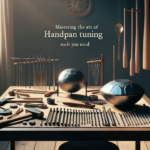Handpans have captured the imagination of musicians and listeners alike, largely due to their enchanting, ethereal sound. The construction and crafting of a handpan play a critical role in defining its sound quality. This article explores the complex process behind creating those perfect harmonics that make handpans so special.
The Anatomy of a Handpan
Understanding the anatomy of a handpan is essential when diving into its sound quality. A handpan consists of two metal hemispheres glued together to form a hollow, resonant shell. The top shell contains several note fields, usually arranged around a central note called the “ding.” These note fields are created by hammering the metal into tuned indentations.
The Science of Harmonics
Harmonics are integral to the unique sound of a handpan. When a note field is struck, it produces a fundamental frequency, as well as a series of overtones or harmonics. These harmonics are usually tuned to create a harmonious relationship with the fundamental tone. Quality handpans feature harmonics that are carefully tuned to create a rich, resonant sound.
Materials and Construction
The choice of material significantly impacts the sound quality of a handpan. Most quality handpans are made from nitrided steel or stainless steel. Nitrided steel undergoes a chemical process to increase its hardness and resistance to corrosion, which results in a brighter and more sustained sound. Stainless steel, meanwhile, provides a warmer and more mellow tone.
The construction process is meticulous, involving hundreds of hours of precise hammering, tuning, and refining. Expert handpan makers often tune each note field several times, ensuring that the harmonics are perfectly aligned with the fundamental frequency.
The Role of the Tuner
The tuner plays a pivotal role in shaping the handpan’s tonal quality. A skilled tuner adjusts the tension and curvature of each note field by hammering it meticulously. This ensures that the fundamental frequency and its corresponding harmonics are in perfect harmony. Small deviations in tuning can lead to dissonance, which diminishes the overall sound quality of the handpan.
Achieving Perfect Harmonics
Achieving perfect harmonics requires a combination of science and artistry. The process begins with selecting the right alloy and tempering the metal to achieve the desired stiffness and flexibility. The next step involves shaping the metal into a dome and creating the note fields through precise hammering.
The tuner then fine-tunes each note field, ensuring that the primary and secondary harmonics align perfectly. This involves alternating between mechanical tuning tools and auditory checks, where the tuner listens for any dissonance and makes the necessary adjustments. The goal is to create a harmonious relationship among all the notes, resulting in a rich, resonant sound.
The Impact of Design
The design of a handpan also influences its sound quality. Different scales and note layouts can create varying emotional impacts. Some common scales include the D minor Kurd, Celtic, and Integral scales. Each scale has its unique harmonic qualities and can evoke different emotions in the listener.
For example, the D minor Kurd scale is known for its mysterious and melancholic feel, while the Celtic scale tends to sound uplifting and hopeful. A well-designed handpan takes into account the desired emotional impact and tunes the harmonics to enhance this effect.
Custom vs Mass-Produced Handpans
One major distinction in the world of handpans is the difference between custom-made and mass-produced instruments. Custom handpans are typically crafted by artisans who invest significant time and effort into perfecting each instrument. Each note field is meticulously tuned, resulting in outstanding sound quality.
Mass-produced handpans, on the other hand, often lack the same level of craftsmanship. While they can still produce decent sound quality, these instruments may have inconsistencies in tuning and less resonant harmonics. For those serious about playing the handpan, investing in a custom-made instrument is often worth the additional cost.
Maintaining Sound Quality
Once you’ve acquired a quality handpan, maintaining its sound quality is crucial. Regular cleaning and proper storage can help prevent rust and other damage. Many players also recommend avoiding playing with rigid mallets, as these can dent the note fields and negatively impact the harmonics.
Periodic retuning by a professional is another important aspect of maintenance. Over time, even the best-crafted handpans can go slightly out of tune. A professional tuner can realign the harmonics, ensuring that the instrument continues to produce a rich, resonant sound.
The Spiritual and Emotional Connection
Beyond the technical aspects, the handpan offers a spiritual and emotional connection for both players and listeners. The harmonics can evoke feelings ranging from tranquility to profound introspection. Many handpan players describe a meditative state when they play, finding solace in the instrument’s soothing sounds.
This emotional resonance is partly due to the careful crafting and tuning of the harmonics. A well-made handpan doesn’t just produce beautiful sounds – it creates a deeply emotional experience for anyone who listens to it.
Conclusion
The art of crafting perfect harmonics in a handpan is a complex, multifaceted process that combines science, art, and craftsmanship. From the choice of materials to the meticulous tuning process, every element plays a vital role in defining the instrument’s sound quality. A well-crafted handpan offers not just beautiful music, but also a deeply emotional and spiritual experience, making it a truly unique instrument.
FAQs
1. What materials are commonly used to make quality handpans?
Most quality handpans are made from nitrided steel or stainless steel. Nitrided steel offers a brighter, more sustained sound, while stainless steel provides a warmer, more mellow tone.
2. How long does it take to make a custom handpan?
Creating a custom handpan is a time-consuming process, often involving hundreds of hours of work. This includes selecting materials, shaping the metal, creating note fields, and multiple rounds of fine-tuning.
3. What are some popular handpan scales?
Some popular handpan scales include the D minor Kurd, Celtic, and Integral scales. Each scale has unique harmonic qualities that can evoke different emotions in the listener.
4. Can I maintain and retune my handpan myself?
While regular cleaning and proper storage can help maintain a handpan, retuning should generally be done by a professional. Amateur tuning can result in permanent damage to the instrument.
5. What differentiates custom-made handpans from mass-produced ones?
Custom-made handpans are crafted with a high degree of precision and artistry, resulting in superior sound quality. Mass-produced handpans often have inconsistencies in tuning and less resonant harmonics.





